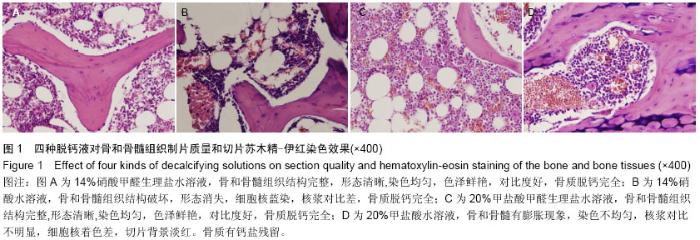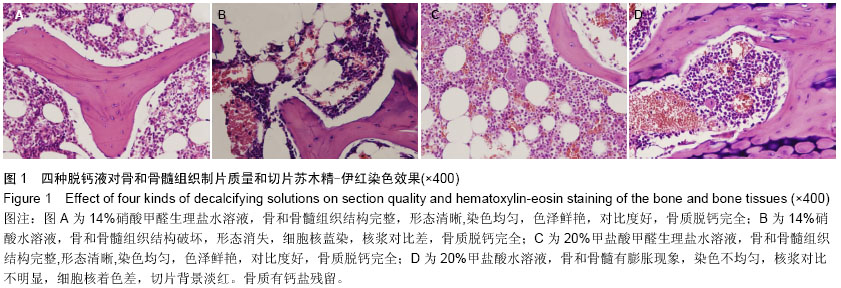| [1] Fugaro JO,Nordahl I,Fugaro OJ,et al.Pulp reaction tovital bleaching.Operative Dentistry.2004;29(4):363-368.
[2] 杜娟,柳剑英,苏静,等.两种组织脱钙法对免疫组织化学染色影响比较[J].北京大学学报:医学版,2011,43(2):290-291
[3] Trebacz H, Zdunek A,Dys W,et al.Effects of nonenzymaticglycation on mechanical properties of demineralized bonematrix under compression.J Appl Biomater Biomech.2011;9(2):144-149. [4] 潘利锋, 吴旭, 夏建军,等 .不同脱钙液对牙齿牙周联合石蜡切片HE染色的影响[J].中国疗养医学, 2009,18(12):1123-1125.
[5] 梁艳清.六种固定液对冰冻切片苏木素伊红染色效果的比较[J].解剖学研究,2012,34(2):159-160.
[6] 胥维勇,杨群.脱钙方法与脱钙液的选择及应用[J].中国组织化学与细胞化学杂志,2002,11(3):263-263.
[7] 张绪斌,熊正文,张华东,等.骨组织脱钙技术及其应用[J].医学理论与实践,2011,24(11):1264-1266.
[8] 王伯沄,李玉松,黄高昇,等.病理学技术[M].北京:人民卫生出版社, 2000: 943-944.
[9] 王爽,曾汉英,杨淑艳.骨组织脱钙后除酸方法的改进[J].第四军医大学吉林军医学院学报,2003,25(2):86.
[10] 崔京淑.改良脱钙液在骨髓穿刺组织制片中的应用[J].吉林医学, 2011,32 (22 ):4460-4461.
[11] 罗灿峤,莫木琼,钟觉民,等. 不同的脱钙液在骨组织制片中的比较应用[J]. 中国实用医药,2011,6(19):27-29.
[12] 张春丽,侯树勋,赵彦涛,等.复合配方脱钙液处理兔股骨髁标本[J]. 中国组织工程研究, 2012,16(50):9364-9369.
[13] 谢玲,邹丽宜,张志平,等.改良脱钙液制作脱钙骨石蜡切片与传统方法的比较[J].中国组织工程研究与临床康复,2008,12(11): 2125-2128.
[14] 熊正文,李宏伟,黄勇,等.骨组织脱钙技术及在免疫组织化学染色中的应用[J].中国比较医学杂志,2004,14(3): 177-178.
[15] 甘启焕,杨清绪,沈琴,等. 提高骨髓石蜡切片质量的几点体会[J].临床与实验病理学杂志,2011,27(1):107-108.
[16] 万蕾,章锦才,轩东英,等.不同脱钙方式观察牙髓组织切片的效果比较[J]. 广东医学,2012,33(7):917-918.
[17] 兰淼,巩丽,李艳红,等 .不同脱钙液对骨髓组织切片HE染色效果的对比研究[J].陕西医学杂志,2010, 39(10): 1299-1301.
[18] 龚志锦,詹镕洲.病理组织制片和染色技术[M].上海:上海科学技术出版社,1994:7.
[19] 孙廷谊,孔令非.骨与钙化组织脱钙方法的改进[J].郑州大学学报:医学版, 2003, 38(6): 980-981.
[20] 刘大维,初同伟,张良,等.微波脱钙骨的免疫组织化学染色[J].第三军医大学学报,2003,25(1):77-78.
[21] 席越,王戈平,黄啸原,等.骨组织病理解剖学技术[M].人民卫生出版社,1997:126-143.
[22] 王红梅,赵春矛,牟阳,等.改良的硝酸脱钙液HE制片方法探讨[J].实用肿瘤学杂志,2005,19(2);151-152.
[23] 杨红. Jy-Ⅱ脱钙液在骨髓活检中的应用[J].中国现代医生,2014, 52(24):46-48,51.
[24] 王毅.长骨恶性骨肿瘤髓腔浸润范围的影像学与病理学的对比研究[D].郑州大学,2014.
[25] 罗灿峤,莫木琼,聂钊铭,等.穿刺活检组织常规石蜡和常规冰冻HE 制片的比较[J]. 山东医药,2014,54(41):22-24.
[26] 夏朝霞.改良骨髓脱钙液对免疫组化染色结果的影响[J文].现代实用医学,2014,26(8):1002-1003.
[27] 张婉仪,阮君,丘展龙.骨组织病理制片三种脱钙液的比较[J].吉林医学,2014,35(10):2083-2084.
[28] 黄蓉飞,江亮,龙小艺,等.改良混合脱钙液在骨髓活检组织中的应用[J].成都医学院学报, 2014,9(6):719-721.
[29] 马少卿,张亚莉.骨髓活检标本固定液的改良[J].诊断病理学杂志, 2013,20(2):119.
[30] 谢燕,黄晓楠,陈红.Rapidcal.Immuno在骨髓脱钙中的应用[J].诊断病理学杂志,2012,19(5):399.
[31] 马少卿.骨髓活检标本脱钙方法的改良[J]. 诊断病理学杂志, 2012,19(2):110.
[32] 倪军,王红,顾健,等.骨髓活检标本脱钙在塑料包埋中的应用[J]. 实用医技杂志,2012,19(9):985-985.
[33] 甘启焕,杨清绪,朱淑玲,等.骨髓活检标本脱钙及除酸方法的改良[J].诊断病理学杂志,2011,18(2):151-151.
[34] 陈世梁,卢志承,董玉英.介绍一种改良脱钙液在骨组织制片中的应用[J]. 临床与实验病理学杂志,2009,25(5):557-555.
[35] 缪勇建.介绍一种骨髓穿刺活检的理想脱钙剂及其HE染色法[J]. 广西医科大学学报,2008,25(2):311-311. |

